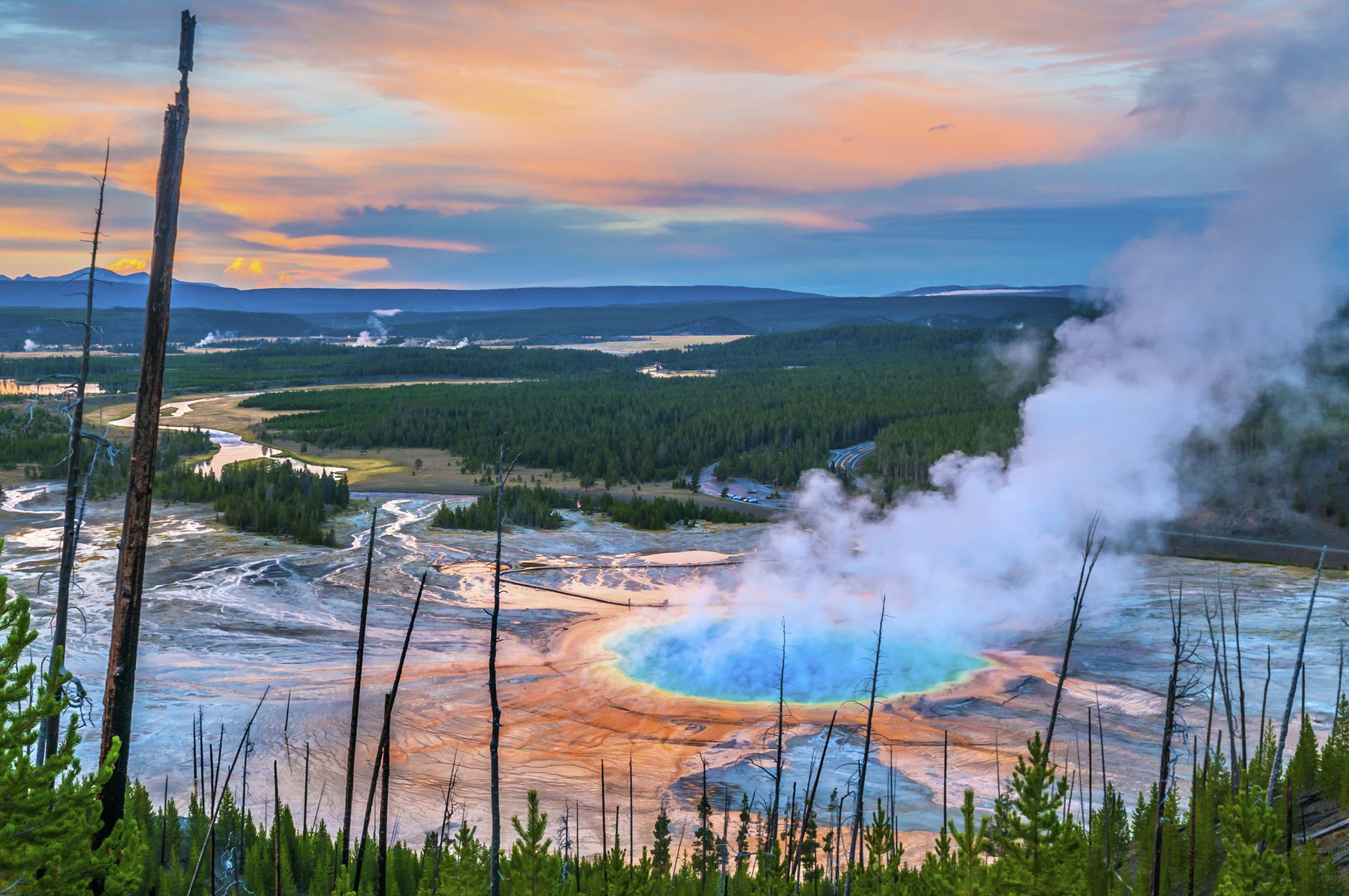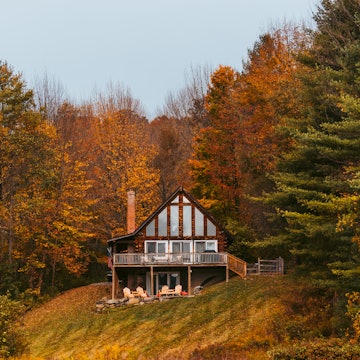
Both of Montana’s national parks are true treasures. Here’s how to get the most out of them

Jul 15, 2024 • 7 min read

Montana’s two national parks offer countless moments of natural beauty – such as the view of Grinnell Lake at Glacier National Park.
When it comes to natural beauty in the USA, Montana sets the gold standard.
The Treasure State’s rugged mountains, endless forests and rich wildlife remain largely pristine thanks to wilderness preservation programs, low population density and the state’s sheer size, which allows outdoorsy types to enjoy all that Montana has to offer. Given Montana’s unparalleled natural attractions, it’s no surprise that the first national park in the United States was established here.
While it’s true that Yellowstone National Park is shared with neighboring Wyoming and Idaho, Montana is the primary gateway to this slice of America’s natural history, with thermal features and wild animals you’ll find nowhere else in the country (or the world). While Yellowstone showcases the wild landscapes as they’ve always been, Glacier National Park – entirely within Montana, even if its geologic features extend into Canada – offers some of the state’s best hikes, with endless trails, towering cliffs and sparkling lakes galore to explore.
Read on to learn why both of Montana’s iconic national parks should be part of any itinerary to the Rocky Mountains and the American West.

Glacier National Park
Montana’s best national park for hiking
In Glacier National Park, towering mountain peaks overlook crystal blue lakes surrounded by dense pine forest, all home to the largest concentration of grizzly bears in the world.
While hiking trails are the star attractions here, there is a lot to see even for non-hikers. A kayak ride across Lake McDonald immerses you in the scenery, and photographing the multicolored river stones beneath the shockingly clear (and cold) water provides a closer-in view. Driving Going-to-the-Sun Rd, an east-west drive transecting the park, is so in demand that it can lead to traffic jams during busier times (generally July and August).
If you want to hike, you’ll be spoiled for choice: more than 700 miles of trails are accessible, most leading to stunning views you’ll find nowhere else in the country. The most popular routes include the hike to Avalanche Lake, a relatively flat and easy trek. A 10-mile out-and-back with 2000ft of elevation gain, the Grinnell Glacier hike leads to a stunning glacier and its lake on the eastern side of the park. Along the way, you’ll enjoy expansive views of the park’s characteristic cliffs and the green valleys below them. Reachable from the parking lot at Logan Pass, the Highline Trail is another must, as is the Hidden Lake Trail.

Visiting Glacier National Park
Visiting Glacier National Park requires serious advance planning. Its roads, hotels and trails are all seasonal, and the park’s popularity has skyrocketed in recent years as the frenzy for road trips and #VanLife has swept the country.
Glacier National Park has seven entrances in total, three of which connect to Going-to-the-Sun Rd. The most used entrances are at West Glacier on the western side of the park and the east entrance at St Mary. Both of these are open year-round but may have closures due to snow; the east entrance, on tribal land, is sometimes closed by decree of the Blackfeet Nation.
Several hotel options lie within the park’s boundaries, including the historic Many Glacier Hotel and Lake McDonald Lodge. There are plenty of campgrounds, too, some of which take reservations, others being first come, first served. You can also apply for a backcountry permit if wilderness camping is your thing.

Outside the park, several gateway towns with hotels and campgrounds cluster by the park’s west side. West Glacier is the closest town to the park’s border, with West Glacier Village offering cozy cabins and an RV park that are perfect starting points for a Glacier adventure. Thirty miles west is the ski resort town of Whitefish, south of which is Kalispell, a (relatively) larger city that hosts Glacier Park International Airport (FCA). On the east side, the Tiny Homes at St Mary Village offer a unique option for accommodations.
As with Yellowstone, booking far in advance is recommended for trips from June to September. Under The Big Sky Festival takes place in Whitefish in mid-July, causing serious competition for even the least desirable campsites.
Entering Glacier in a standard vehicle costs $35 (except on fee-free days), unless you have the $80 annual National Park Pass or are a military veteran or 4th grader with the respective annual pass. In 2021, a $2-per-vehicle ticket was implemented to access Going-to-the-Sun Rd between 6am and 5pm during the summer months. Getting the permit was competitive and not always guaranteed, and while it’s possible to see parts of the park while avoiding GTTSR, it’s not easy or recommended.

Yellowstone National Park
Montana’s best national park for natural history
It’s easy to see how Yellowstone National Park helped lead officials in the expanding United States to conserve huge swathes of the American wilderness. In 1872, at a time when westward expansion was on a tear, it was Yellowstone’s iconic, unique and now world-famous features that inspired forward-thinking planners to designate this treasure as a federally protected area.
Today, the park is not just one of the best places to visit in Montana – it regularly tops the list of attractions across the 50 states. Visitors today are captivated by the same sights that amazed in the 1800s, in particular dazzling hydrothermal features and unparalleled wildlife.
The 3471-sq-mile park is packed with bubbling hot pots and more than 500 bursting geysers; the best known is Old Faithful, a relatively predictable spewer. Scattered among the waterworks are herds and packs of some of America’s most recognizable animals, including bison, gray wolves, grizzly bears, elk and bald eagles. All-but-guaranteed sightings of such abundant wildlife is a main reason more than 4 million visitors come here annually, predominantly during the summer.

Yellowstone’s most memorable attractions begin outside the park in Gardiner, the gateway to the park’s north entrance and the site of the famous Roosevelt Arch. (A line of cars winding beneath the gate is standard any time of day in the summer, so getting a photo isn’t too hard.) Just inside the west entrance is the town of Mammoth, including the spires of Mammoth Hot Springs, another popular photo spot. Elk frequently wander around Mammoth – but be sure not to approach, feed or touch them. Also, take care never to walk between a bull and any of his cows, as he’ll take that as an act of aggression.
Other popular attractions include the multicolored Grand Prismatic Spring, the largest hot spring in the United States. (Note that the best view of its otherworldly orange-blue colors is not from the boardwalk winding through the spring, but from a nearby elevated platform along the Fairy Falls Trail.) Yellowstone Canyon (also called the “Grand Canyon of Yellowstone”) is another photo op most visitors won’t want to miss. Park at Artist Point to view the canyon and Lower Falls in all their glory.
In addition to geological features, the park is also known for Old Faithful Inn, a historic wood-and-stone landmark next to the geyser of the same name. It’s a great place to stop for lunch or just poke in to admire the antique architecture (if you want to spend the night, count on reserving 12 to 24 months in advance). Hayden and Lamar Valleys are the most reliable spots to find Yellowstone’s wildlife, particularly the predator species. Bison are fairly difficult to miss anywhere in the park.

Visiting Yellowstone National Park
As at Glacier, taking a trip to Yellowstone will require some planning, especially during July and August when it’s busiest. Old Faithful Inn and Roosevelt Lodge offer in-park accommodation, and there are also 12 campgrounds with over 500 sites within the park. The gateway towns of Gardiner at the north entrance and West Yellowstone at the west entrance offer abundant accommodations just outside the park’s borders; Bozeman, with the nearest airport, is equidistant from both entrances. Livingston, Big Sky and Paradise Valley also offer accommodations with relatively close access to the park. In every case, booking ahead will be essential during the high season.
In winter, only the road from the north entrance in Gardiner to Cooke City stays open. Some accommodations may be closed during this time, but there are enough available rooms to sustain the minimal crowds. This is the best time to see wolves and other wildlife that have congregated in the Lamar Valley for the winter. Cooke City is also a very common spot to find snowmobilers, though winter travelers are unlikely to encounter them within the vast park. In any case, come prepared for freezing temperatures and suboptimal driving conditions.
Entering Yellowstone is not free (except on fee-free days): each standard vehicle must pay $35 at the gate – which we highly recommend so you can explore the park on your own schedule. Alternatively, consider a National Park Pass for $80, which provides a year’s access to every national park in the country. Military personnel (including veterans) and 4th graders may acquire annual passes for free. Once in the park, no site is fee-restricted.















